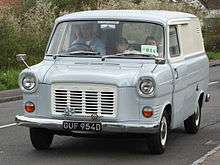Genk Body & Assembly
Genk Body & Assembly was a Ford Motor Company automobile factory in Genk, Belgium, just over an hour to the west of the company's European head office in Cologne. The site spanned 6,135,630 square feet (140.9 acres). The plant employed approx 4,300 workers in 2014.[1]

The plant opened in the early 1960s. The first mainstream car built there was Ford's first front wheel drive volume model, the Ford Taunus P4. Later on the plant focused on producing mid-sized family cars including the company's Sierra and Mondeo models.
Models built
| Imager | Model | Years | Number | Image | Model | Years | Number | |
|---|---|---|---|---|---|---|---|---|
| Ford Taunus P4 12M | 1963-1966 | 314.270 | Ford Mondeo II | 1996-2000 | 1.200.069 | |||
| Ford Taunus P5 17M | 1965-1966 | 13.765 |  | Ford Transit VI | 2000-2004 | 384.238 | ||
 | Ford Transit II/III/IV/V | 1965-2000 | 1.857.635 |  | Ford Mondeo III | 2000-2007 | 1.418.515 | |
| Ford Taunus P6 12M/15M | 1966-1970 | 518.602 |  | Ford S-MAX I | 2006-2010 | 235.890 | ||
 | Ford Escort | 1968-1970 | 258.205 |  | Ford Galaxy III | 2006-2010 | 120.192 | |
 | Ford Taunus P7 20M | 1969-1970 | 19.534 | Ford Mondeo IV | 2007-2010 | 567.582 | ||
| Ford Taunus | 1970-1982 | 2.695.796 | .jpg) | Ford Mondeo IVb | 2010-2014 | |||
 | Ford Sierra I | 1982-1992 | 2.741.713 | Ford S-MAX Ib | 2010-2014 | |||
 | Ford Mondeo I | 1992-1996 | 1.362.538 | Ford Galaxy IIIb | 2010-2014 |
Closure
Ford announced in October 2012 that it was planning to close its Genk plant at the end of 2014 in response to longstanding over-capacity problems in Europe,[2][3] as part of a larger closure plan that will see the manufacturer's European capacity slashed by 20%, with further capacity cuts penciled in should the company not succeed in returning to higher European sales volumes.[4] The next generation of Ford Mondeo will be assembled, for the European market, at the manufacturer's Valencia plant.
Reports in March 2013 indicated that agreement with the workers' representatives would see Ford paying out an average of €144,000 (at the time equivalent to US$187,500) for each of the 4,000 workers to be laid off. It was noted that this was significantly below the US$202,700 per worker that had been the price reportedly paid by General Motors at the closure in 2010 of their Antwerp facility.[4]
At the end of 2016 it was estimated that the decontamination of the site would cost 11.4 million euros.[5]
See also
References
- Belgium:Genk Body and Assembly Archived 2015-04-12 at the Wayback Machine origin-corporate.ford.com. Retrieved April 6, 2015.
- "Newspress".
- "Ford confirms plans to close Belgian factory". 24 October 2012 – via www.bbc.co.uk.
- "187.500 pro Arbeiter: Ford erkauft sich Werksschließung in Genk".
- "Sanering sterk vervuilde zones Ford Genk zal 11,4 miljoen euro kosten". Het Belang van Limburg (in Dutch). 31 December 2016. Retrieved 15 June 2017.